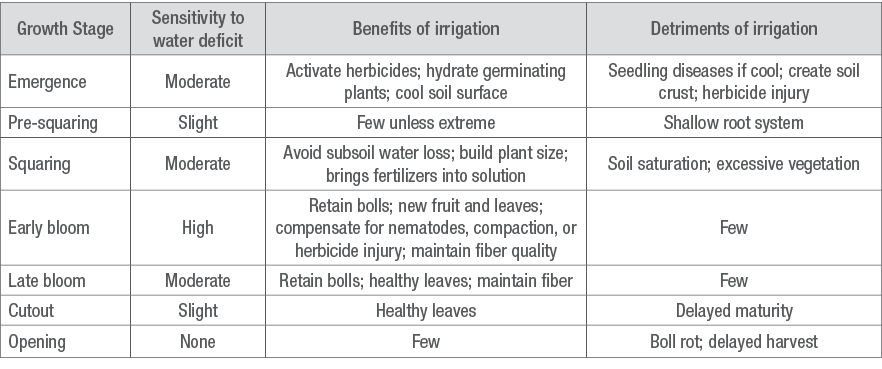5 MIN READ
Irrigation Scheduling for Cotton
January 26, 2022
Cotton Water Demands
Key Points:
- The sensitivity of cotton to water stress varies by growth stage.
- Irrigation may improve cotton emergence and is important to establish a good plant stand, nutrient uptake, prevent water stress induced square and boll shedding, help maintain fiber quality, and support maximum yield potential.
- Once cotton plants emerge, irrigation should be used to supplement rainfall and prevent depletion of the soil moisture profile prior to bloom and throughout most of the growing season.
- First square to first bloom growth stages is a critical time for avoiding drought stress in cotton.
- Cotton irrigation strategy in the arid and semi-arid regions of the West may be significantly different from irrigation strategy in the rain belt.
Cotton is an indeterminate perennial shrub that is somewhat tolerant to drought and soil salinity. Because of its drought adaptations, cotton responds favorably to periods of water stress enough to slow vegetative growth; a physiological feature that can be benefited by timely irrigation management.1 Irrigation is necessary for supplying water in arid and semi-arid regions of the West and helps supplement rainfall in other regions.2 The benefits of supplemental irrigation to reduce soil water deficit are many. The challenge in optimizing irrigation is providing enough water at critical cotton growth stages to supplement rainfall, without causing excessive plant stress from excess soil moisture.3 Regardless of the region, the goal of water management is to meet crop demand and optimize yield with the resources available.2
Irrigating in Arid Regions
Irrigation is the dominant influence on cotton yield in arid climates. Growers who expect to produce top yields must have the capacity to irrigate their entire acreage over 7 to 10 days to allow precise applications of water.2 Pre-irrigation is often necessary in arid regions. This helps provide a soil profile that is full of moisture to the rooting depth, drained of excess surface water, and warmed by the sun prior to planting. Filling the soil profile delays the need for the first post-planting irrigation and helps prevent potential problems such as: evaporation loss of valuable water, plant cooling, nitrate leaching, and potential soil borne pathogen infection.2
Timing of the first post-planting irrigation is critical. Growers must consider well capacity and the irrigation system’s ability to supply enough water to meet crop needs at critical growing stages. Starting too early may lead to chilling injury (when temperatures remain below 80o F)2, potential development of seedling diseases, a shallow root system, weed germination, and rank vegetative growth. Starting too late may lead to stunted plants, early cutout, and reduced yield potential. Cutout is the point when the terminal is five nodes above the uppermost first position white flower.4 Optimum irrigation timing in the West occurs when plants are slowing mainstem growth, but before obvious leaf color changes.2 Once irrigation is started, most growers in arid regions will need to continue supplying water throughout the growing season to prevent loss of yield potential from water stress (Table 1). While water requirements are higher in the West, so are yields.

